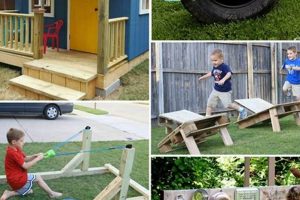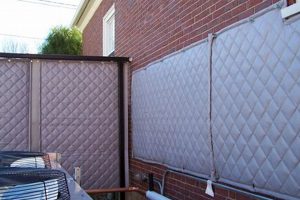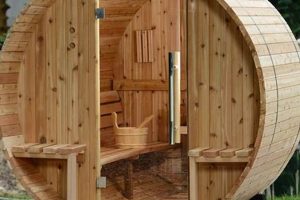Creating a personal open-air washing space involves constructing a dedicated area for bathing outside, typically connected to a water source and drainage system. These installations range from rudimentary setups using repurposed materials to more elaborate structures incorporating enclosed spaces and sophisticated plumbing. The design frequently emphasizes natural elements, privacy considerations, and ease of use.
The addition of an external cleansing station can significantly enhance the outdoor living experience. It offers a convenient way to rinse off after activities such as swimming, gardening, or beach visits, preventing the tracking of dirt and debris indoors. Historically, these amenities have been utilized in warmer climates and coastal regions, providing a functional and aesthetically pleasing addition to residential properties and recreational areas.
The following sections will explore various approaches to building these outdoor bathing facilities, including considerations for location, materials, construction techniques, and aesthetic design to enable the creation of a functional and visually appealing addition to outdoor spaces.
Construction Guidance
The following provides guidance to facilitate the successful construction of an open-air washing space. Careful planning and execution are essential for a functional and aesthetically pleasing outcome.
Tip 1: Location Selection: Prioritize a site with adequate drainage and access to existing plumbing lines to minimize installation complexity and potential environmental impact. Consider sun exposure and prevailing winds for user comfort.
Tip 2: Privacy Measures: Implement screening techniques using fencing, vegetation, or strategically placed walls to ensure user privacy and compliance with local regulations. Ensure the screening adequately obscures the bathing area from all sightlines.
Tip 3: Material Durability: Opt for weather-resistant materials such as cedar, redwood, or composite decking for the structure’s framework and flooring. These materials offer longevity and minimize maintenance requirements in outdoor environments.
Tip 4: Plumbing Considerations: Consult local plumbing codes and regulations before initiating any water line modifications. Employ frost-proof fixtures if the system is intended for year-round use in colder climates. Proper pipe insulation is crucial.
Tip 5: Drainage Implementation: Install a proper drainage system to prevent water pooling and potential erosion. Options include French drains, gravel beds, or connection to existing stormwater management systems. Compliance with environmental regulations is mandatory.
Tip 6: Fixture Selection: Choose showerheads and controls that are specifically designed for outdoor use. Consider features such as adjustable spray patterns and temperature control for enhanced user experience.
Tip 7: Foundation Stability: Ensure the structure has a solid and level foundation. This may involve the use of concrete footings, gravel pads, or other stabilization techniques, depending on soil conditions and local climate.
Adherence to these guidelines will increase the likelihood of creating a durable, functional, and aesthetically pleasing open-air bathing area. Proper planning minimizes future maintenance needs and maximizes user satisfaction.
The subsequent sections will delve into design considerations and styling options to further customize the bathing area to align with individual preferences and existing landscape architecture.
1. Location
The selection of an appropriate location is a foundational element in the development of an outdoor bathing area. Placement directly impacts the installation’s accessibility, privacy, and integration with existing utilities and landscape architecture. For example, proximity to a pre-existing water supply and drainage system can substantially reduce construction costs and complexity. Conversely, a site distant from these resources may necessitate extensive and costly modifications to existing infrastructure.
Furthermore, the chosen location influences the user experience. A site exposed to prevailing winds may require windbreaks, while a location with ample sunlight will naturally warm the bathing area. Considerations of privacy from neighboring properties or public spaces are paramount. Real-world examples include utilizing existing fences or hedges for natural screening or strategically positioning the structure to minimize visibility from adjacent areas. Moreover, local building codes and regulations frequently dictate permissible locations, mandating setbacks from property lines or adherence to drainage requirements. Understanding these regulatory constraints is crucial to ensure compliance and avoid potential legal issues.
In summary, the strategic selection of a site is not merely a matter of preference but a critical determinant of the success, cost-effectiveness, and regulatory compliance of the project. Addressing the issues related to location is paramount for a positive outcome of the initiative. Disregarding location can result in functional shortcomings, increased expenses, or legal complications. Integrating the project into an environment that compliments its design is paramount.
2. Plumbing
Plumbing constitutes a core functional component of any outdoor bathing space, directly influencing its usability and effectiveness. A properly implemented system delivers water to the showerhead at an adequate pressure and efficiently removes wastewater, preventing pooling and potential environmental damage. The complexity of plumbing requirements depends on factors such as the desired water temperature (cold only or hot and cold), the distance from existing water lines, and local climate conditions. For instance, in regions subject to freezing temperatures, plumbing lines require insulation or winterization to prevent damage.
The connection of plumbing to an existing water supply typically involves tapping into an existing outdoor faucet or running a new line from the main water supply. Selection of appropriate pipe materials, such as copper, PEX, or PVC, is crucial, considering factors such as cost, durability, and resistance to corrosion. Moreover, backflow prevention devices are often mandated by local codes to prevent contamination of the main water supply. Drainage systems can range from simple gravel beds for greywater infiltration to connection to the municipal sewer system. The selection of drainage method depends on local regulations and environmental considerations. Failure to properly address drainage can lead to soil erosion, water accumulation, and potential health hazards.
In summary, plumbing is not merely a supplementary element; rather, it represents an integrated and indispensable aspect of an outdoor bathing space. Proper planning and execution of the plumbing system are essential for the shower’s functionality, longevity, and compliance with applicable codes and environmental standards. Neglecting the intricacies of plumbing can lead to operational inefficiencies, costly repairs, or regulatory violations, ultimately diminishing the value and enjoyment of the outdoor bathing space. In summary, the proper establishment and function of the plumbing are critical for the value and enjoyment of the shower as a whole.
3. Privacy
The implementation of an outdoor bathing space invariably necessitates a thorough consideration of privacy. The primary function of such a structure is compromised if users are subjected to unwanted observation. The degree of privacy required is often dictated by individual preferences, local regulations, and the proximity of neighboring properties. A failure to adequately address privacy concerns may render the shower unusable or create potential legal issues related to public indecency or nuisance laws. The provision of appropriate screening mechanisms, therefore, becomes a paramount design consideration. For example, in densely populated urban areas, a fully enclosed structure with solid walls may be necessary to ensure adequate seclusion. Conversely, in more rural settings, strategically positioned landscaping or partial screening may suffice.
Methods for establishing privacy range from natural barriers such as hedges, trees, or climbing plants to constructed elements like fences, screens, or walls. The selection of an appropriate method should consider the aesthetic integration of the structure with the surrounding landscape. For instance, a bamboo fence may complement a tropical-themed garden, while a stone wall may better suit a more rustic aesthetic. Material selection also plays a role in durability and maintenance requirements. Wooden fences require periodic staining or sealing, while composite materials offer greater longevity with less maintenance. Furthermore, the height and density of the screening should be carefully considered to ensure effective concealment from various viewpoints. An inadequate barrier may provide a false sense of privacy while failing to prevent observation from elevated vantage points or distant locations.
In summary, privacy is an indispensable element in the design and construction of a functional and enjoyable outdoor bathing space. The implementation of appropriate screening mechanisms, tailored to the specific site conditions and user preferences, is crucial for ensuring user comfort, compliance with local regulations, and the long-term usability of the structure. Neglecting privacy considerations can undermine the intended purpose of the outdoor shower and create potential legal or social complications. The design and construction of a DIY outdoor shower must address privacy needs to ensure its functional success.
4. Materials
Material selection represents a critical decision point in the design and construction of outdoor bathing spaces. The durability, aesthetics, and overall longevity of the structure are directly contingent upon the materials employed. The following points explore critical facets of material selection in the context of constructing such structures.
- Structural Framework Materials
The structural framework, providing the foundation and support for the entire enclosure, typically employs wood, metal, or composite materials. Wood, such as cedar or redwood, offers natural resistance to decay and insect infestation. Metal frameworks, often constructed from aluminum or galvanized steel, provide superior strength and resistance to weathering. Composite materials, combining wood fibers and plastics, offer a low-maintenance alternative with increased resistance to moisture damage. The selection necessitates a balance between cost, aesthetics, and anticipated environmental exposure.
- Plumbing Materials
Plumbing materials, responsible for water delivery and drainage, must withstand constant exposure to moisture and varying temperatures. Copper pipes offer excellent corrosion resistance and thermal conductivity, but their cost can be prohibitive. PEX tubing provides a flexible and cost-effective alternative, while PVC pipes are suitable for drainage applications. Frost-proof fixtures are essential in climates subject to freezing temperatures to prevent damage to the plumbing system. Understanding local plumbing codes and material compatibility is crucial for a safe and effective installation.
- Enclosure and Screening Materials
Enclosure and screening materials determine the degree of privacy and aesthetic appeal of the bathing space. Options range from natural elements such as bamboo or reeds to manufactured materials like wood fencing, composite panels, or fabric screens. Bamboo provides a sustainable and visually appealing option, while wood fencing offers a more traditional and secure enclosure. Composite panels offer low-maintenance and customizable designs. The choice depends on the desired level of privacy, the surrounding landscape, and personal preferences.
- Surface Materials
Surface Materials, particularly the shower floor, requires careful selection to ensure slip resistance, drainage, and ease of cleaning. Concrete provides a durable and customizable surface, while wood decking offers a natural and aesthetically pleasing alternative. Stone pavers or pebbles provide a rustic aesthetic with inherent drainage properties. Regardless of the material chosen, proper slope and drainage are essential to prevent water pooling and potential slip hazards. Furthermore, the surface material should be resistant to staining, mildew growth, and degradation from prolonged exposure to water.
The selection of appropriate construction components directly impacts the functionality, durability, and aesthetic integration of these bathing facilities within an outdoor environment. The careful consideration of properties for resistance to weathering, maintenance requirements, and the overall aesthetic cohesion with the surrounding landscape ensures a successful outcome. A design prioritizing material selection is essential for a facility that is both practical and visually appealing.
5. Drainage
Effective drainage constitutes a fundamental consideration in the planning and construction of outdoor bathing facilities. The proper management of wastewater is essential for preventing soil erosion, water accumulation, and potential environmental contamination. A poorly designed drainage system can lead to structural damage, health hazards, and regulatory violations. Therefore, implementing an adequate drainage solution is not merely an aesthetic concern but a critical functional and environmental imperative.
- Wastewater Volume and Composition
The volume of wastewater generated by an outdoor shower directly impacts the design requirements of the drainage system. Higher usage rates necessitate larger capacity systems to prevent overflow and standing water. Furthermore, the composition of the wastewater, which may include soap, shampoo, and other cleaning agents, must be considered. Certain soaps may be harmful to plant life or contaminate groundwater, requiring specialized filtration or treatment systems.
- Drainage System Types
Various drainage system types exist, each with its own advantages and disadvantages. Gravel beds provide a simple and cost-effective solution for dispersing wastewater into the surrounding soil. French drains, consisting of a perforated pipe buried in gravel, offer improved drainage capacity and prevent soil clogging. Connection to the municipal sewer system provides the most reliable and environmentally sound solution but may require permits and incur additional costs. The selection of an appropriate system type depends on site conditions, wastewater volume, and local regulations.
- Environmental Considerations
The environmental impact of wastewater disposal is a paramount concern. Direct discharge of untreated wastewater into waterways or onto the ground can contaminate surface and groundwater resources. Compliance with local environmental regulations is essential to prevent pollution and protect public health. Permeable paving materials can reduce runoff and promote groundwater recharge. Utilizing biodegradable soaps and shampoos minimizes the environmental impact of wastewater. Careful consideration of environmental factors is crucial for sustainable and responsible drainage practices.
- Construction and Maintenance
Proper construction and maintenance are essential for the long-term functionality of the drainage system. The installation of gravel beds and French drains requires careful attention to soil compaction and pipe slope. Regular inspection and cleaning of the system are necessary to prevent clogging and ensure efficient drainage. Over time, soil particles and organic matter can accumulate in the drainage system, reducing its capacity. Periodic maintenance, such as flushing the system with water or replacing the gravel, is essential for maintaining its effectiveness.
The efficient and responsible management of wastewater forms an indispensable facet of any open-air bathing space. Implementation of a well-designed drainage system prevents environmental damage, reduces the risk of health problems, and maintains structural integrity. Addressing drainage correctly enhances both the functionality and sustainability of these amenities. The design and construction of a DIY outdoor shower must address drainage needs to ensure its functional success.
6. Structure
The structural component of open-air bathing spaces is paramount, serving as the foundational element that dictates stability, safety, and overall design integrity. The framework provides physical support for plumbing fixtures, screening elements, and any ancillary features, such as benches or storage shelves. A structurally unsound framework compromises the entire installation, potentially leading to collapse, water damage, or personal injury. Consider, for example, a basic design utilizing repurposed wood pallets. Without proper reinforcement and weather treatment, such a structure would quickly degrade, rendering the bathing area unusable and potentially hazardous. The structural design must account for anticipated loads, including the weight of users, water pressure, and environmental factors such as wind and snow.
The choice of structural materials directly impacts the longevity and maintenance requirements of the outdoor bathing facility. Pressure-treated lumber provides resistance to rot and insect infestation, while metal frameworks offer superior strength and durability. However, both materials require proper installation techniques and periodic maintenance to prevent corrosion or structural failure. Consider a more elaborate structure incorporating a tiled shower floor and multiple showerheads. Such a design necessitates a robust foundation capable of supporting the increased weight and water volume. A failure to adequately reinforce the foundation could result in cracking, settling, or even structural collapse. Local building codes and regulations often specify minimum structural requirements for outdoor structures, including foundation depth, beam sizing, and bracing techniques. Adherence to these codes is essential to ensure safety and prevent legal complications. A poorly supported platform and walls risk collapse with use.
In summary, the structural component is not merely an aesthetic consideration but a fundamental determinant of the safety, durability, and overall functionality of an outdoor bathing space. A robust and well-designed framework ensures the longevity of the installation and provides a secure and enjoyable bathing experience. Neglecting the structural integrity compromises the entire endeavor, potentially resulting in costly repairs, safety hazards, or regulatory violations. Therefore, it is imperative to prioritize structural design and construction in the creation of such an amenity. The strength and security of the entire structure depend on the structural design.
7. Aesthetics
The aesthetic component of open-air bathing installations significantly influences the user experience and the overall integration of the structure within its environment. While functionality remains paramount, visual appeal contributes substantially to the perceived value and enjoyment of the space. The aesthetic design encompasses elements such as material selection, color palettes, spatial arrangement, and the incorporation of decorative features. The effect of these choices directly impacts the sense of relaxation, privacy, and harmony experienced by the user. For example, the use of natural materials such as wood and stone can create a sense of connection with nature, promoting a more tranquil and restorative bathing experience. Conversely, the incorporation of harsh, synthetic materials may detract from the desired atmosphere. A practical illustration involves comparing two installations: one constructed from unfinished pressure-treated lumber with exposed plumbing and another employing cedar siding, concealed plumbing, and strategically placed foliage. The latter demonstrably enhances the user’s perception of the space and its overall desirability.
The interplay between the structure and its surroundings necessitates careful consideration of the existing landscape architecture. An outdoor bathing area should complement, rather than clash with, the surrounding environment. This may involve matching the architectural style of the main dwelling, mirroring the color scheme of the garden, or incorporating elements that reflect the local climate and vegetation. For instance, a coastal property might benefit from the incorporation of nautical-themed elements such as rope accents, driftwood detailing, or a whitewashed finish. A rustic setting, conversely, might be enhanced by the use of reclaimed wood, exposed stone, and naturalistic plantings. Furthermore, the integration of lighting can significantly enhance the aesthetic appeal of the space, particularly during evening use. Strategically positioned landscape lighting can create a warm and inviting ambiance, while task lighting ensures adequate visibility for safe and comfortable bathing.
In conclusion, the aesthetic dimension of open-air bathing installations is not merely a superficial consideration but an integral component of the overall design process. Thoughtful attention to visual details enhances the user experience, promotes a sense of harmony with the surrounding environment, and contributes to the long-term enjoyment of the space. Ignoring the principles of aesthetics can result in a functional but uninviting structure that detracts from, rather than enhances, the outdoor living environment. Balance between functional design with aesthetic appeal is the key to a successful project.
Frequently Asked Questions
The following addresses common inquiries regarding the design, construction, and maintenance of personal, open-air washing facilities. These questions aim to provide clarity on various aspects of the endeavor.
Question 1: What permits are typically required for constructing an outdoor bathing area?
Permit requirements vary significantly based on local building codes and regulations. Generally, permits may be necessary for plumbing modifications, electrical work, and structural alterations. Consultation with the local building department is advisable to ascertain specific permit requirements prior to commencing construction.
Question 2: How can water be heated for an outdoor bathing facility?
Water heating options include connection to the existing home water heating system, installation of a dedicated tankless water heater, or utilization of a solar water heating system. Each option presents varying levels of cost, complexity, and energy efficiency. Assessment of individual needs and resources is essential for determining the most suitable approach.
Question 3: What measures can be taken to prevent freezing damage to outdoor plumbing lines?
Preventative measures include insulating pipes with foam or heat tape, installing frost-proof faucets, and draining the plumbing system during periods of freezing temperatures. Underground burial of pipes below the frost line provides additional protection against freezing. The specific approach should align with local climate conditions and frequency of freezing events.
Question 4: What are the recommended materials for creating a slip-resistant shower floor?
Suitable materials include textured concrete, wood decking with anti-slip coating, and natural stone with a rough surface. Adequate slope for drainage is crucial to prevent water pooling and minimize slip hazards. Consideration should be given to both traction and cleanability when selecting surface materials.
Question 5: How can privacy be effectively achieved in an outdoor bathing space?
Privacy solutions include the construction of solid walls, the installation of lattice screens, or the strategic planting of dense vegetation. The height and density of the screening should be sufficient to obscure the bathing area from all sightlines. Consideration should be given to both immediate and long-term growth patterns of any plant-based screening solutions.
Question 6: What are the best practices for maintaining an outdoor bathing structure?
Regular maintenance includes cleaning the showerhead to prevent mineral buildup, inspecting plumbing for leaks, and treating wood surfaces to prevent rot and insect infestation. Periodic inspection of the structural framework is advisable to identify and address any signs of deterioration. Prompt attention to maintenance needs extends the lifespan of the installation.
These frequently asked questions provide a foundation for understanding the key considerations involved in creating an outdoor bathing amenity. Proper planning and execution are critical for ensuring a safe, functional, and aesthetically pleasing result.
The subsequent section offers a concise summary of the core principles outlined in this document, reinforcing the key takeaways for successful project completion.
Conclusion
The construction of an outdoor bathing space, explored within the context of do-it-yourself construction, demands a multifaceted approach encompassing location analysis, plumbing considerations, privacy measures, material selection, drainage implementation, structural integrity, and aesthetic design. Neglecting any of these core components compromises the functionality, longevity, and safety of the resulting amenity. The principles outlined herein offer a framework for informed decision-making throughout the planning and execution phases.
The creation of a personal open-air washing facility represents a significant undertaking requiring meticulous planning and diligent execution. The information presented serves as a foundation for realizing such projects successfully. Further research and adherence to local regulations are essential for ensuring a safe, sustainable, and aesthetically pleasing addition to any property. The ultimate success of any DIY outdoor shower hinges on careful preparation, skilled execution, and a commitment to long-term maintenance.







